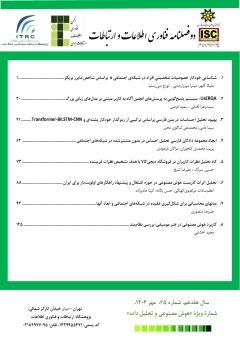کاربرد هوش مصنوعی در هنر موسیقی: بررسی نظاممند
محورهای موضوعی : هوش مصنوعی و رباتیک
1 - دانشگاه پیام نور، تهران، ایران
کلید واژه: هوش مصنوعی, موسیقی, تولید موسیقی, یادگیری ژرف,
چکیده مقاله :
فناوری هوش مصنوعی علیرغم عمر کوتاهش که از حدود سال 1960 توسط جان مک کارتی آغاز شد، تقریبا به تمامی عرصهها ورود جدی داشته است و آن را تحت تاثیر شگفتیهای خود قرار داده است، ازجمله هنر موسیقی. پژوهش حاضر با هدف شناخت و معرفی کاربردهای هوش مصنوعی در موسیقی، به بررسی نظاممند ادبیات موضوع هوش مصنوعی و کاربردهای آن در هنر موسیقی پردازد. برای نیل به این هدف ابتدا 5 حوزه پرکاربرد تحقیقاتی و کاربردی هوش مصنوعی در موسیقی مدنظر قرار گرفته است. سپس اطلاعات تمامی اسناد علمی مرتبط با این 5 حوزه از پایگاه استنادی اسکوپوس استخراج شده است. در هر یک از 5 حوزه کشورهایی با بیشترین مقالات چاپ شده، دانشگاههایی که بیشترین مقالات را چاپ کردهاند و نویسندگان برتر استخراج گردید. علاوه بر این روند زمانی چاپ اسناد علمی مرتبط با هر حوزه مشخص گردید. در ادامه روشهای و الگوریتمهای مختلف هوش مصنوعی که در هر یک از حوزهها مورد استفاده قرار گرفتند مشخص شده و مقالات متناظر با هر یک از آنها نیز مشخص شده است. یادگیری ژرف در تمامی حوزهها در حال تغییر و بهبود نتایج بوده و سبب رشد کمی پژوهشهای علمی در حوزه موسیقی شده است. علاوه بر این هوش مصنوعی مولد در حیطه تولید موسیقی رشد چشمگیری را در رقم زده است. در نهایت نیز چالشها و موضوعات آینده تحقیقاتی حوزههای مختلف بررسی شده است. از مهمترین کارهایی که میتوان در آینده انجام داد، تهیه مجموعه دادگان مناسب برای حوزههای مختلف است.
"Despite its relatively short history, dating back to around 1960 when John McCarthy initiated the field, artificial intelligence (AI) has made significant inroads into nearly all domains, profoundly impacting them. Music is no exception. This research aims to systematically review the literature on AI and its applications in music, with the goal of understanding and introducing the various uses of AI in this art form. To achieve this, five primary research and application areas of AI in music were identified. Subsequently, data from all relevant scientific documents within these five areas was extracted from the Scopus database. For each of the five areas, the countries with the highest number of published articles, the universities with the most publications, and the top authors were identified. Additionally, the temporal trend of scientific document publication in each area was determined. Furthermore, the various AI methods and algorithms employed in each area were identified, along with the corresponding articles. Deep learning has been transforming and improving results in all areas, leading to a quantitative growth in scientific research within the field of music. Moreover, generative AI has experienced remarkable growth in the realm of music production. Finally, the challenges and future research topics of the different areas were examined. One of the most crucial tasks for the future is the creation of suitable datasets for various domains."

